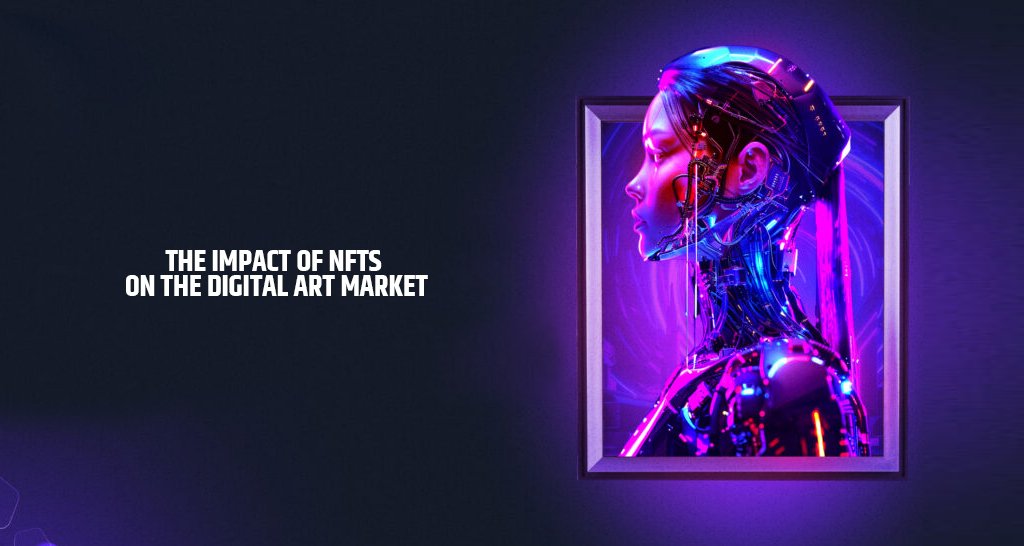Introduction to NFTs and Digital Art
Non-fungible tokens, commonly known as NFTs, are a form of digital asset that represents ownership or proof of authenticity of a unique item, often stored on blockchain technology. Unlike cryptocurrencies such as Bitcoin or Ethereum, which are fungible and can be exchanged for one another, NFTs are distinct and cannot be replaced with something identical. This characteristic makes NFTs particularly suitable for digital art, as they enable artists to tokenize their creations and attach a verifiable ownership record, ensuring originality and rarity.
The purpose of NFTs extends beyond mere ownership; they facilitate a new way for artists to monetize their work. By creating NFTs from digital artworks, artists can sell their pieces directly to collectors, bypassing traditional intermediaries. This can lead to increased revenue for artists, as they can set their prices and receive royalties on subsequent sales through smart contract programming. The integration of blockchain technology secures the transaction records, providing transparency and legitimacy in the digital art marketplace.
Digital art, in its various forms, has a rich history predating the rise of NFTs. Initially, digital creations faced significant challenges in terms of recognition and monetary valuation. Artists often struggled to prove ownership and faced issues with piracy and unauthorized reproduction, leading to a reluctance from both collectors and investors to engage with this medium. Prior to NFTs, digital artworks could be easily copied, undermining their perceived value. However, with the advent of NFTs, a revolutionary shift occurred, empowering artists to protect their work and offer collectors a secure and tangible investment. As the digital art landscape evolves, the introduction of NFTs continues to reshape the ways artists create, share, and monetize their work in this burgeoning market.
The Rise of NFT Technology
The emergence of Non-Fungible Tokens (NFTs) represents a significant technological advancement within the digital art market. The genesis of NFTs can be traced back to the early 2010s with the creation of colored coins on the Bitcoin blockchain. However, it was the introduction of Ethereum, with its smart contract capabilities, that revolutionized the concept of ownership and authenticity in digital assets. In 2017, projects like CryptoPunks and CryptoKitties demonstrated the potential of NFTs, enabling users to buy, sell, and trade uniquely identifiable digital assets.
As interest in cryptocurrency surged, various platforms emerged, facilitating the buying and selling of NFTs. Notable marketplaces such as OpenSea, Rarible, and Foundation provided artists and collectors with the infrastructure needed to engage in secure transactions, appealing to a global audience. These platforms were critical in simplifying the process of minting, buying, and selling NFTs, expanding accessibility beyond tech-savvy users to the broader public.
In early 2021, NFTs entered mainstream consciousness when artist Beeple sold a digital artwork at Christie’s for a staggering $69 million, marking a pivotal moment in the art world. This sale captured global attention and spurred a wave of interest in NFTs, prompting other artists to explore the medium and encouraging collectors to invest in digital art. The spotlight also highlighted how NFTs can provide artists with new revenue streams, such as royalties from future sales, thereby reshaping the traditional art market dynamics.
The integration of cryptocurrencies into the NFT ecosystem is another vital factor driving this market growth. Cryptocurrencies serve as the currency of choice for many NFT transactions, enhancing the appeal of digital art ownership. Through these developments, NFTs have not only transformed how art is created and consumed but have also sparked conversations about digital ownership, value, and the future of the creative economy.
Transforming Ownership and Authenticity in Art
The advent of non-fungible tokens (NFTs) has significantly transformed the landscape of ownership and authenticity within the digital art market. Traditionally, art ownership involved physical pieces, where provenance could be traced through collectors and galleries. However, NFTs have introduced a new paradigm, allowing digital artworks to be owned and traded in a transparent and verifiable manner. This shift has resulted in a redefinition of what it means to own art in the digital realm.
At its core, an NFT is a digital certificate of ownership that is securely stored on a blockchain. This technology provides a level of authenticity that was previously unattainable for digital artworks, which can be easily replicated. With an NFT, each piece of art is linked to a unique token that confirms its originality and ownership. Consequently, artists can now create a robust digital provenance trail for their works, giving collectors confidence in the authenticity of what they purchase. This newfound assurance is crucial in a market that has historically struggled with issues of forgery and duplication.
The implications of this transformation extend beyond individual artists and collectors; galleries and institutions are also adapting to this shift. They are starting to recognize the value of NFTs not just as a sales tool, but as a means of engaging with audiences in new ways. By embracing NFTs, galleries can create virtual exhibitions that highlight digital art forms, reaching a global audience without the constraints of physical space. As a result, ownership and authenticity are evolving, leading to innovative ways for artists to monetize their work and for collectors to invest in value-aided assets.
This transformation has opened up an array of possibilities in the digital art market, establishing a new framework that prioritizes authenticity and establishes clear ownership rights. It is an evolving landscape that promises to continue influencing the relationship between artists, collectors, and the artwork itself.
Economic Impact on Artists and Creators
The emergence of Non-Fungible Tokens (NFTs) has significantly transformed the economic landscape for artists and creators in the digital art market. By providing a mechanism for verifying ownership and authenticity of digital content, NFTs have opened up new revenue streams that were previously unattainable. One notable advantage is the ability for artists to engage in direct sales of their work, bypassing traditional intermediaries such as galleries or auction houses. This direct-to-consumer approach allows creators to retain a larger share of the profits generated from their artworks, thus optimizing their earnings.
Furthermore, NFTs facilitate the implementation of royalties on secondary sales. This feature ensures that artists receive a percentage of sales whenever their work changes hands in the digital marketplace. In essence, this model fosters a sustainable income for creators, encouraging them to continue producing high-quality art. The inclusion of royalties not only enhances an artist’s financial security but also aligns the economic incentives of the creators with the ongoing value of their work, cultivating a more equitable ecosystem.
Additionally, the NFT market provides access to a global audience, allowing artists to showcase their creations to buyers across diverse geographical regions. This expanded visibility can lead to increased sales and engagement, enabling creators to build their brand and connect with art enthusiasts worldwide. The digital nature of NFTs also reduces the barriers for entry, making it feasible for emerging artists to enter the market without the significant costs associated with other forms of physical art sales.
Despite these considerable economic benefits, it is crucial for artists and creators to be aware of the potential challenges and risks associated with this new market. Issues such as market volatility, environmental concerns related to energy consumption of blockchain technologies, and the occasional lack of buyer trust in digital assets may pose threats to long-term sustainability. Navigating this complex landscape requires careful consideration and strategic planning on the part of artists and creators.
Changing Consumer Behavior and Market Dynamics
The emergence of Non-Fungible Tokens (NFTs) has remarkably transformed consumer behavior within the digital art market. Traditionally, art collectors have engaged with tangible pieces, valuing physical attributes and provenance. However, with the rise of NFTs, consumers are now shifting their focus toward digital ownership and provenance, redefining what it means to possess art. This paradigm shift is fueled by an increasing acceptance of digital mediums as valid forms of artistic expression, which reflects broader cultural changes towards technology and ownership.
One notable trend in the buying and selling of NFTs is the emergence of a more diversified collector base. The dismantling of geographical and economic barriers has allowed artists and collectors worldwide to engage in a thriving ecosystem. This increased accessibility encourages participation from younger generations, tech-savvy individuals who are often motivated by both speculative investment opportunities and a desire to support their favorite creators. As such, this demographic actively seeks out unique digital artworks, leading to a more dynamic market environment.
Additionally, the motivations behind purchasing NFTs extend beyond mere aesthetic appeal. Buyers are often driven by the desire for status and community. Owning a sought-after NFT often signifies a prestige that resonates within the digital art community. This cross-section of art and technology has fostered new types of social interaction, where owners may showcase their collections on social media platforms, enhancing their personal brand and engagement with like-minded individuals.
Consequently, the overall dynamics of the art market have evolved, with digital artworks increasingly gaining recognition at auctions and exhibitions. Traditional galleries are now adapting their business models to accommodate digital artworks, further legitimizing the NFT market. As this shift continues, it is evident that NFTs are not only reshaping consumer behavior but are also having a lasting impact on the fundamental structure of the art market itself.
Environmental Concerns and Sustainability Issues
The rise of non-fungible tokens (NFTs) has brought a wave of creativity and innovation in the digital art market; however, it has also sparked considerable debate regarding their environmental impact. One of the primary criticisms associated with NFTs is the substantial energy consumption linked to blockchain technology, particularly for platforms that utilize proof-of-work systems. These platforms require enormous computational power to validate transactions, leading to high carbon emissions and raising alarms among environmental advocates.
Various studies indicate that the energy demands of maintaining such blockchains can rival those of entire countries, which poses a significant challenge for sustainability within the art community. Digital artists and collectors must acknowledge that while NFTs can democratize art ownership, they also contribute to environmental degradation. The good news is that there are emerging alternatives aimed at minimizing this ecological footprint.
To address these concerns, some NFT platforms are transitioning to more sustainable practices. For instance, proof-of-stake systems are gaining traction as they consume significantly less energy than their proof-of-work counterparts. In this model, transaction verification relies on validators rather than complex computations, resulting in a far lower carbon footprint. Furthermore, several initiatives have been launched to offset emissions generated from NFT transactions, promoting carbon-neutral token creation and trading.
Additionally, artists and collectors are encouraged to explore platforms that prioritize sustainability or to participate in eco-friendly projects. As awareness grows regarding the urgent need for environmentally conscious solutions, the digital art market is gradually adapting to uphold both innovation and responsibility. By making informed choices about blockchain technology usage, stakeholders can contribute to a more sustainable future for the burgeoning NFT art space.
Legal and Copyright Implications
The advent of Non-Fungible Tokens (NFTs) has undoubtedly transformed the digital art market, bringing to the forefront several legal and copyright implications. NFTs serve as a means of ownership verification for digital creations, but they do not automatically grant copyright or intellectual property rights to the purchaser. This distinction is crucial for both artists and buyers, as it impacts the ownership of the underlying artwork. Typically, the original creator retains their copyright unless explicitly transferred through a contract.
The legal landscape surrounding NFTs is still developing, leading to uncertainty regarding intellectual property rights. Artists should consider how their works are represented in NFT formats, ensuring that they have clear terms concerning reproduction rights, distribution, and usage. Utilizing a smart contract—an integral part of the blockchain technology supporting NFTs—can help artists specify the rights they intend to retain or transfer along with the NFT. This practice is vital not only for securing their rights but also for creating transparency in transactions.
Additionally, artists need to be aware of the implications of selling digital content as an NFT, including potential infringements of another’s intellectual property. For instance, artwork that incorporates elements from existing works without permission could lead to legal challenges. Therefore, thorough due diligence is advisable before proceeding with an NFT sale. The importance of copyright registration remains paramount, as it serves as a critical deterrent against unauthorized reproductions and theft in the increasingly crowded NFT space.
As the NFT marketplace evolves, educators and legal experts emphasize the need for artists to stay informed about the legal frameworks related to digital assets. By understanding their rights and utilizing appropriate protections, creators can navigate this new landscape more effectively, ensuring that they maintain control over their artistic outputs while exploring the opportunities that NFTs present.
Future Trends in the Digital Art Market with NFTs
The digital art market is witnessing transformative changes fueled by the adoption of non-fungible tokens (NFTs). As we look to the future, several trends appear poised to shape this dynamic landscape. One notable trend is the evolution of digital art forms themselves; the integration of NFTs encourages artists to explore innovative techniques and mediums, leading to the emergence of new styles and genres. Artists may increasingly experiment with interactive and immersive experiences, such as augmented and virtual reality, which can be tokenized as unique collectibles.
Advancements in technology are also expected to significantly impact the digital art market. Blockchain technology underpins NFTs, providing artists with secure ownership records and transparent transaction history. As technology continues to evolve, we may see improvements in blockchain scalability and efficiency, which could enhance the overall user experience. Furthermore, developments in artificial intelligence and machine learning may facilitate more sophisticated digital art creation tools, allowing artists to experiment with algorithm-generated artwork that can be minted as NFTs.
Another significant shift could be the increasing integration of NFTs into traditional art institutions and galleries. More galleries are exploring ways to incorporate digital art and blockchain technology into their offerings, potentially establishing dedicated sections for NFTs. This crossover may enhance the legitimacy of digital art within the broader art market, attracting collectors who may not have previously engaged with the medium. Consequently, as traditional institutions adapt to these trends, they may foster greater acceptance and valuation of NFT artworks.
As the digital art market continues to evolve with the influence of NFTs, stakeholders, including artists, collectors, and institutions, must remain adaptable and open to new possibilities. Understanding these emerging trends will be crucial for navigating this rapidly changing landscape.
Conclusion: The New Era of Digital Art
As we have explored throughout this discussion, the advent of Non-Fungible Tokens (NFTs) marks a significant shift in the digital art market. By providing artists with a mechanism to assert ownership and authenticity over their creations, NFTs are fostering a more equitable relationship between creators and audiences. This transformative technology not only empowers artists but also challenges traditional notions of art value and provenance.
NFTs facilitate a direct connection between artists and their collectors, eliminating intermediaries that typically dominate the art world. This direct relationship allows artists to benefit from sales without the disproportionately high fees associated with galleries and auction houses. The use of blockchain technology ensures that ownership and transaction history are transparent and immutable, granting both artists and collectors confidence in their investments.
Furthermore, the ability to program royalties into smart contracts allows artists to receive a percentage of future sales. This innovative feature enables ongoing revenue streams, which is particularly crucial for digital artists whose work may be easily copied or distributed. Consequently, NFTs are not only providing a new revenue model but also redefining how artists engage with their audience.
In addition to these economic implications, the rise of NFTs is also altering the cultural landscape of the art market. Digital art is gaining recognition and legitimacy, appealing to a broader audience while blending the realms of technology and creativity. As more individuals enter the space, the ways in which art is perceived and consumed are continually evolving, suggesting that we are on the brink of a new era in the art world.
Overall, the impact of NFTs on the digital art market is profound and multifaceted, heralding a future where artists, collectors, and audiences can interact in unprecedented ways. As this technology continues to develop, its potential to further shape the digital art landscape remains significant.



